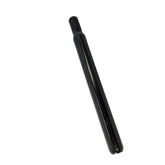Bicycle Seat (Saddle), Seat Posts, and Seat Nuts are key components of a bicycle that contribute to comfort, performance, and safety. These parts connect the rider to the bike, making them crucial for an enjoyable cycling experience. Over time, these parts may wear out, break, or need adjustments, which is why understanding their function, types, and maintenance is important. Let’s explore each of these components and their spare parts in detail.
Bicycle Saddle
The saddle (or seat) is where the rider sits while cycling. It plays a crucial role in comfort, as the right saddle can reduce discomfort, improve posture, and enhance overall performance.
Types of Bicycle Saddles
-
Road Bike Saddles:
-
Description: Road bike saddles are typically narrow and lightweight, designed for long-distance cycling. These saddles minimize friction and allow for an aerodynamic riding position.
-
Advantages: Reduced weight and increased efficiency, allowing for longer rides with less resistance.
-
Common Use: Road bikes, racing bikes, triathlon bikes.
-
Mountain Bike Saddles:
-
Description: Mountain bike saddles are often wider and more padded than road bike saddles, designed for comfort during off-road rides. They also have more robust construction to withstand rough trails.
-
Advantages: Extra padding and durability for rough, uneven surfaces.
-
Common Use: Mountain bikes, trail bikes.
-
Hybrid/Commuter Saddles:
-
Description: These saddles are a middle ground between road bike and mountain bike saddles. They tend to be more comfortable, with more padding, but still efficient enough for commuting or casual riding.
-
Advantages: Offers comfort and support for short to medium distances, perfect for urban commuting or leisurely cycling.
-
Common Use: Hybrid bikes, commuter bikes.
-
Cruiser Saddles:
-
Description: Used on cruiser bikes, these saddles are extra wide with thick padding to provide maximum comfort for relaxed, leisurely rides.
-
Advantages: Comfort-focused, ideal for casual cycling with a more upright riding posture.
-
Common Use: Cruiser bikes, recreational bikes.
-
Gel Saddles:
-
Description: Gel saddles have a layer of gel padding that provides extra cushioning and absorbs shocks, making them ideal for longer rides.
-
Advantages: Superior comfort and shock absorption, reducing pressure on sensitive areas.
-
Common Use: Touring bikes, commuter bikes, long-distance cycling.
-
Saddles with Cutouts:
-
Description: Some saddles feature a cutout in the middle or other ergonomic designs to reduce pressure on the perineal area, which can cause discomfort during long rides.
-
Advantages: Improved comfort and reduced pressure on sensitive areas.
-
Common Use: Road bikes, mountain bikes, long-distance cycling.
Bicycle Saddle Spare Parts
-
Saddle Rails:
-
Description: Saddle rails are the metal bars that connect the saddle to the seat post. They are usually made of steel, aluminum, or carbon fiber.
-
When to Replace: If the rails are bent, cracked, or damaged, the saddle may become unstable or uncomfortable. Replace the saddle if this happens.
-
Saddle Cover:
-
Description: Some saddles come with a cover that helps protect the saddle from the elements and wear.
-
When to Replace: If the cover becomes torn, worn out, or faded, consider replacing it for improved protection and comfort.
-
Saddle Padding:
-
Description: The padding inside the saddle can wear down over time, affecting comfort.
-
When to Replace: If the saddle becomes uncomfortable or loses its cushioning, the padding may need to be replaced.
-
Saddle Clamp/Adapter:
-
Description: This component connects the saddle rails to the seat post and allows for saddle adjustments.
-
When to Replace: If the clamp becomes damaged or the saddle is not securely attached, it may need to be replaced.
Bicycle Seat Post
The seat post is the component that connects the saddle to the frame of the bicycle. It allows you to adjust the saddle's height, and sometimes its angle, for a more comfortable riding position.
Types of Bicycle Seat Posts
-
Standard Seat Post:
-
Description: A simple cylindrical seat post that fits into the seat tube of the bike frame. Most seat posts are designed to be adjusted by raising or lowering them.
-
Advantages: Provides basic adjustment of saddle height, reliable for most types of cycling.
-
Common Use: Road bikes, mountain bikes, hybrid bikes.
-
Suspension Seat Post:
-
Description: These seat posts incorporate a shock-absorbing system, often using springs or elastomers, to reduce the impact on the rider’s seat when riding over rough terrain.
-
Advantages: Provides added comfort by absorbing shocks from uneven surfaces, ideal for mountain biking or rough terrain.
-
Common Use: Mountain bikes, touring bikes, city bikes.
-
Dropper Seat Post:
-
Description: A type of seat post that allows you to adjust the saddle height on the fly using a remote control, typically used on mountain bikes.
-
Advantages: Quick and easy saddle height adjustment, which is useful for descending or navigating technical terrain.
-
Common Use: Mountain bikes, trail bikes.
-
Offset Seat Post:
-
Description: These seat posts have a slight bend or offset, positioning the saddle slightly rearward. This can improve comfort or riding position.
-
Advantages: Helps customize the bike fit, particularly for riders who need a slightly more relaxed or rearward saddle position.
-
Common Use: Road bikes, triathlon bikes.
Bicycle Seat Post Spare Parts
-
Seat Post Clamp:
-
Description: The clamp secures the seat post in place within the seat tube of the bike frame.
-
When to Replace: If the clamp becomes stripped, cracked, or damaged, it will no longer hold the seat post securely in place, requiring replacement.
-
Seat Post Bolt:
-
Description: This bolt secures the saddle to the seat post. Depending on the design, it may also allow you to adjust the angle of the saddle.
-
When to Replace: If the bolt becomes stripped, rusted, or damaged, it can affect the saddle's stability.
-
Seat Post Collar:
-
Description: The collar surrounds the top of the seat tube and holds the seat post in place.
-
When to Replace: If the collar becomes cracked, loose, or damaged, it should be replaced to ensure the seat post stays in place.
-
Seat Post Bushing or Bearings (for Suspension Seat Posts):
-
Description: Suspension seat posts may contain bushings or bearings to enable smooth movement of the shock-absorbing system.
-
When to Replace: If the seat post starts feeling bouncy, stiff, or noisy, the bushings or bearings may need replacing.
Bicycle Seat Nuts
Seat nuts are often used to secure the seat to the seat post or the seat post clamp. Depending on the bike type, they may be part of the saddle mounting system or used in seat post assemblies.
Types of Seat Nuts
-
Saddle Mounting Nuts:
-
Description: These nuts secure the saddle rails to the saddle clamp.
-
When to Replace: If the nuts become stripped, rusted, or damaged, replace them to ensure the saddle stays firmly attached to the bike.
-
Seat Post Clamp Nuts:
-
Description: These nuts secure the seat post clamp around the seat tube.
-
When to Replace: If the nuts become loose, rusted, or stripped, it can result in the seat post shifting. Replace them to maintain a secure saddle position.
Maintenance Tips for Saddles, Seat Posts, and Seat Nuts
-
Regular Adjustment: Ensure that your saddle height and angle are properly adjusted for comfort. An incorrect saddle position can cause discomfort, strain, and even injury.
-
Lubrication: Lightly grease the seat post before inserting it into the seat tube. This helps prevent seizing and makes adjustments easier.
-
Check Tightness: Periodically check the saddle and seat post bolts for tightness. Loose components can cause instability or discomfort while riding.
-
Inspect for Wear: Look for signs of wear on the saddle rails, seat post, and seat post clamp. If any parts are bent, cracked, or damaged, replace them immediately to prevent accidents.
-
Clean Regularly: Clean your saddle and seat post to remove dirt and debris. This helps maintain comfort and ensures that parts move smoothly when adjusted.
Conclusion
The saddle, seat post, and seat nuts are essential components of your bicycle, directly affecting comfort, control, and your riding experience. Choosing the right parts for your riding style, whether it’s a road bike, mountain bike, or commuter bike, and maintaining them properly will ensure a comfortable and safe ride.










